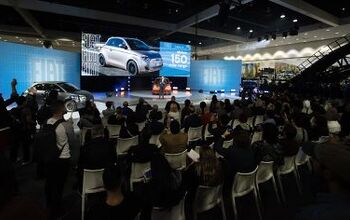Piston Slap: The Case for the Front-Mounted Transaxle?

DAG writes:
Why don’t automakers design front-wheel-drive cars with the transaxle in front of the engine? This moves the front wheels forward and improves weight distribution; offers better potential for aerodynamics and leaves space under the hood for pedestrian protection. With a turbo four-cylinder, the engine could have clearance from the firewall. Also, the engine and transaxle could be mounted on a pivoting subframe, hinged at the front, to drop down at the back for major maintenance; disconnect steering and exhaust to drop cradle.
The engine would sit in the space where rack and pinion generally resides; steering gear design would be a challenge for direct mechanical actuation. Perhaps traction would be reduced. Would crashworthiness also be affected?
Sajeev answers:
Interesting query! I’m happy to play devil’s advocate to your modern-day Cord powertrain layout:
- Potential aerodynamic benefit is eliminated via pedestrian safety regulations. Larger front fascias increase surface area in contact with humans, thereby reducing physical damage from knee-bending.
- Head protection isn’t likely, thanks to our cab forward designs — more cab, less hood and a greater chance the pedestrian’s head still slams somewhere needing 10 cm of space above the engine intake manifold.
- Hinged subframes bring crashworthiness concerns. While I can’t google up proof, subframes are designed to prevent the engine from intruding into the passenger compartment in a head-on collision. They normally move down and/or under the firewall, and a hinge introduces a fail point in something that must not fail.
- Not concerned about steering system interference; most vehicles use electric steering now.
- V-shaped engines would be tough in this configuration. Perhaps one day we can have a V6 engine renaissance. Perhaps it will lead to something deliciously looney like a second-gen LS4. That’s not likely with this design.
This is probably another case of automakers doing their jobs by not reinventing the wheel, by protecting us from what we want. But hey, if it worked on the Cord …
[Image: Shutterstock user Andy Dean Photography]
Send your queries to sajeev@thetruthaboutcars.com. Spare no details and ask for a speedy resolution if you’re in a hurry…but be realistic, and use your make/model specific forums instead of TTAC for more timely advice.

More by Sajeev Mehta
Latest Car Reviews
Read moreLatest Product Reviews
Read moreRecent Comments
- SCE to AUX All that lift makes for an easy rollover of your $70k truck.
- SCE to AUX My son cross-shopped the RAV4 and Model Y, then bought the Y. To their surprise, they hated the RAV4.
- SCE to AUX I'm already driving the cheap EV (19 Ioniq EV).$30k MSRP in late 2018, $23k after subsidy at lease (no tax hassle)$549/year insurance$40 in electricity to drive 1000 miles/month66k miles, no range lossAffordable 16" tiresVirtually no maintenance expensesHyundai (for example) has dramatically cut prices on their EVs, so you can get a 361-mile Ioniq 6 in the high 30s right now.But ask me if I'd go to the Subaru brand if one was affordable, and the answer is no.
- David Murilee Martin, These Toyota Vans were absolute garbage. As the labor even basic service cost 400% as much as servicing a VW Vanagon or American minivan. A skilled Toyota tech would take about 2.5 hours just to change the air cleaner. Also they also broke often, as they overheated and warped the engine and boiled the automatic transmission...
- Marcr My wife and I mostly work from home (or use public transit), the kid is grown, and we no longer do road trips of more than 150 miles or so. Our one car mostly gets used for local errands and the occasional airport pickup. The first non-Tesla, non-Mini, non-Fiat, non-Kia/Hyundai, non-GM (I do have my biases) small fun-to-drive hatchback EV with 200+ mile range, instrument display behind the wheel where it belongs and actual knobs for oft-used functions for under $35K will get our money. What we really want is a proper 21st century equivalent of the original Honda Civic. The Volvo EX30 is close and may end up being the compromise choice.


































Comments
Join the conversation
"Not concerned about steering system interference; most vehicles use electric steering now." They still have steering columns and steering racks. Main reason I know of is that the space in front of the engine is wasted for crash because it is resisting engine mass as well as the rest of the cabin. If the engine hits the crash barrier immediately then you can use the space behind the engine to decelerate the safety cell.
Doesn't anyone remember the RUXTON? It used a reverse Inline-8 engine-transaxle, FWD design: https://en.wikipedia.org/wiki/Ruxton_(automobile) And it actually slightly pre-dates the Cord. They are VERY rare. Only 33 of them known to remain, with only about 16 in running condition. The latest restored one auctioned for about $370,000. If you want a really fascinating read, check out this thread on its insanely immaculate restoration: http://forums.vwvortex.com/showthread.php?6206837-1932-Ruxton-build-thread-or-quot-How-I-became-an-unwitting-restorer-quot